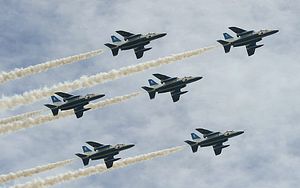I’ve previously in my column discussed the progress of Japan’s Next Generation Fighter (NGF) with great interest, at times making predictions about Japanese decision-making that failed to pan out. Over the past year, Japan has considered partnerships with the United States and the United Kingdom on the new fighter, and may even have given some thought to collaboration with Europe. As Franz Stefan-Gady reports, some of the murk cleared earlier this month when Japan rejected the idea of a partnership with Lockheed Martin. This will give Japan full control over an array of decisions on how to build and eventually market the fighter, including considerably greater freedom on how to export the aircraft.
But even as Japan has decided to go it alone with many aspects of the project, Tokyo has recognized the need to situate the fighter’s requirements and capabilities within the broader Indo-Pacific strategic context. Tokyo was unhappy with the development process of its previous fighter project, the F-2, which was also initiated during a period of trade tensions. Japan wants to remain in close contact with its Pacific allies regarding the capabilities of the Next Generation Fighter. It now appears that Japan is developing an innovative means of communicating with its allies and partners. Stephen Trimble reports on one of the ways that Japan is taking an innovative approach to managing design requirements. As Trimble details, Japan is using the Center for Strategic and International Studies (CSIS) to informally communicate with the U.S., Britain, and Australia regarding the future capabilities of the fighter.
The method of communication is almost as interesting as the discussion itself. Fighter aircraft cost and immense amount of money and embody an immense degree of national pride; consequently, no one wants to say anything that will embarrass a government or a producer. The particular venue for these meetings is relevant in part because of the expertise available at CSIS about military aviation, and in part because the rules of discussion enable privacy without the need for formal, classified communications. According to Trimble, the first meeting included upward of 25 officials and private citizens from the four countries. In some sense, procedures like this are a consequence both of the increasingly arcane systems of classification that have made it difficult for countries to have conversations with one another that are also inclusive of private citizens. The existence of whistle-blower organizations like Wikileaks have also changed the classification landscape by acquiring and releasing non-sensitive information that wins publicity simply by merit of the term “classified.”
This system enables conversation with the assurance that “Chatham House Rules” will prevent attribution of statements to any particular individual, which makes it easier to say politically awkward things while also avoiding cumbersome classification procedures. If it works, it will give Japan and its partners a better sense of what the fighter needs to be.
































